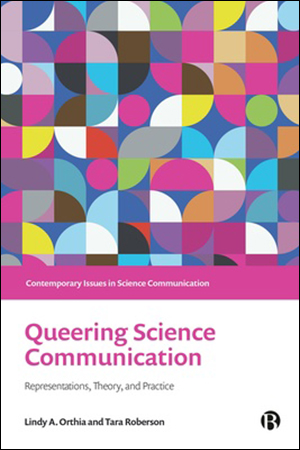At a time in history when trans and non-binary people are experiencing an avalanche of hate and harm, science communicators can no longer sit by and do nothing.
In mid-2024, Australian LGBTIQA+ organisations achieved a hollow victory when the government backtracked on a decision to omit sex, sexuality and gender questions on the next national census, but remained firm on the decision not to include a question on innate variations of sex characteristics. US states racked up a record number of anti-trans bills. Policies directly attacking trans children accumulate in Canada, and England’s Cass Review into trans and gender-diverse healthcare managed to ignore the consensus of medical bodies around the world. Elsewhere in the world, violence against trans people continues apace while trans people and their allies maintain their fights for respect, healthcare and legal recognition.
These policy shifts have everything to do with science and medicine, so science communicators have a crucial role to play in the debate.
Gender affirmation is healthcare
Statistics abound on LGBTIQA+ people’s higher suicide rates, poorer mental health and greater risks of unemployment, poverty and homelessness. They are even worse for trans and non-binary people than for their cisgender queer siblings.
While we can all combat transphobic stigma, prejudice and abuse on a daily basis, we also require structural support in the long-term, including access to gender-affirming care.
Medical researchers have recorded striking improvements in the mental health of trans and non-binary people after receiving gender-affirming care such as puberty blockers, hormones and surgery. Likewise, the mental health of same-sex and multi-sex-attracted people also markedly improves when structural changes are made to reduce stigma and discrimination against them, such as legalising same-sex marriage.
Treating people like human beings is good for them.
Binary sex and gender is a myth
Some of those who oppose trans rights (and trans existence) promulgate misconceptions about sex and gender adhering to a strict, biologically hardwired binary model – there is female and there is male and never the twain.
Science communicators can combat this dangerous idea with the help of an abundance of biological data about non-human animals that mess with the idea of binary sex through sex transitions, intersex variations and even drag. Attraction to others of the same sex or diverse sexes is also common among many animals, defying the heterosexual assumptions that dominated biology in the past.
And never mind other species – cultures all over the globe have been havens for queer people of all stripes for countless centuries, such as the Filipino babaylans and Māori Takatāpui.
People with intersex variations are about as common as redheads on a global scale, yet are frequently subject to unnecessary, harmful and non-consensual medical procedures to force their bodies to conform to narrow cultural expectations of binary sex. They remain unprotected from this common and horrific treatment in most of the world’s jurisdictions despite unproven benefits and catastrophic impacts on health and wellbeing.
Science communicators who value objectivity should not let ideologies of binary sex and gender cause harm to LGBTIQA+ people, or obscure life’s rich tapestry from our eyes.
LGBTIQA+ people and science communication
Last year we published the first book on queerness and science communication, which this month becomes more accessible than ever with its release in paperback. Its 40+ contributors, including many trans and non-binary people from across the world, provide an amazing resource for change in this battle. As they demonstrate, LGBTIQA+ people are working as science communicators of all kinds across the world – as drag performers, museum curators, researchers and more.
And yet, science communication as a field largely fails to platform LGBTIQA+ voices in the mainstream – let alone speak for and protect queer rights. Indeed, LGBTIQA+ people have been and continue to be hurt by discriminatory and harmful practices in science communication and STEM as well as in politics. But this current state does not have to continue.
What can we do?
Science communicators should speak out, speak loud, and speak often.
Be informed: We need to be informed about LGBTIQA+ communities, remain aware of their context and history, and understand the diversity that is sex, gender and sexual orientation.
Visibility matters: We work with diverse communities and the make-up of our field reflects that diversity. We must showcase this quality by making science communication a place where LGBTIQA+ folk are visibly welcome and engaged.
Use our power to help: Science communicators can be powerful in determining the trajectory of conversations in STEM and beyond. We are therefore well positioned to be excellent allies who can platform LGBTIQA+ issues and support our diverse community’s needs.
We have been heartened by the positive reception of our collective work on queering science communication by the international science communication community. Let us now translate that celebration into meaningful action by supporting our trans, non-binary and intersex family, friends and colleagues. The three steps we recommend here are a place to start.
Tara Roberson is a Postdoctoral Researcher at the Australian Research Council Centre for Excellence for Engineered Quantum Systems at The University of Queensland.
Lindy A. Orthia is an Honorary Senior Lecturer of Sociology at The Australian National University.
 Queering Science Communication edited by Lindy A. Orthia and Tara Roberson is available here for £27.99 on the Bristol University Press website.
Queering Science Communication edited by Lindy A. Orthia and Tara Roberson is available here for £27.99 on the Bristol University Press website.
Bristol University Press/Policy Press newsletter subscribers receive a 25% discount – sign up here.
Follow Transforming Society so we can let you know when new articles publish.
The views and opinions expressed on this blog site are solely those of the original blog post authors and other contributors. These views and opinions do not necessarily represent those of the Bristol University Press and/or any/all contributors to this site.
Image credit: Tobias Carlsson via Unsplash


